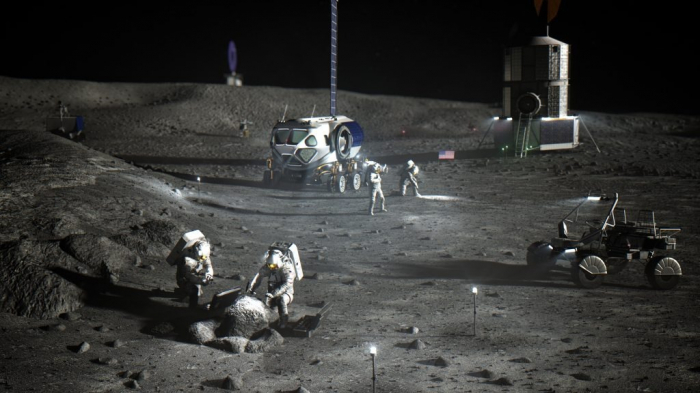Aerospace & Defense
S.Korea-US to deepen aerospace ties through NASA's Artemis
NASA is set to select the final candidate site for the Moon landing with analyses of images captured by S.Korean lunar orbiter
By Apr 25, 2023 (Gmt+09:00)
2
Min read
Most Read
LG Chem to sell water filter business to Glenwood PE for $692 million


Kyobo Life poised to buy Japan’s SBI Group-owned savings bank


KT&G eyes overseas M&A after rejecting activist fund's offer


StockX in merger talks with Naver’s online reseller Kream


Mirae Asset to be named Korea Post’s core real estate fund operator



South Korea and the US are set to deepen their partnership in the aerospace sector through the Artemis program, a human and robotic Moon exploration project led by the National Aeronautics and Space Administration (NASA). The two countries also plan to expand their cooperation into other tasks such as analysis of air quality in the Northern Hemisphere.
South Korea’s Minister of Science and ICT Lee Jong-ho and NASA Deputy Administrator Pamela Melroy are scheduled on Tuesday to ink a joint letter of intent for collaboration on space exploration and other scientific work including details on South Korea’s roles in the Artemis program.
They will sign the deal at the US space agency’s Goddard Space Flight Center in Greenbelt, Maryland. South Korean President Yoon Suk Yeol and his delegation are currently in the US on a state visit.
NASA aims to send astronauts to the Moon through the Artemis program in November 2025, more than 50 years since the Apollo 17 mission in 1972, when humans last set foot on the natural satellite or traveled beyond low Earth orbit.
IN COOPERATION WITH DANURI
NASA sent the Artemis I into orbit last November through the Space Launch System, an American super heavy-lift expendable launch vehicle in development by the space administration.
South Korea joined the Artemis project in May 2021. The country’s first lunar orbiter Danuri launched by the Korea Aerospace Research Institute (KARI) is currently capturing images of the far side of the Moon around the lunar South Pole with the NASA-developed ShadowCam.
Danuri orbits about 100 kilometers (62 miles) above the Moon 12 times a day, taking pictures of areas where water was analyzed to exist in the form of ice.
NASA is set to select the final candidate sites for the Moon landing of the Artemis III in 2025 based on analyses of images sent by Danuri.
AIR POLLUTION, DARK MATTER
South Korea and the US plan to strengthen cooperation in other projects such as a program to air pollution in the northern hemisphere from space.
The Chollian-2B, a geostationary satellite launched by the KERI in February 2020, is gauging air pollutants such as fine dust in South Korea, Japan and China with a geostationary environment monitoring spectrometer (GEMS) at an altitude of 36,000 kilometers above the Korean Peninsula.
The US last month launched Intelsat 40e equipped with tropospheric emissions: monitoring of pollution (TEMPO) to measure air pollution in North America.
NASA plans to work on a comprehensive study of air quality in the Northern Hemisphere through additional cooperation with the Sentinel-4, which the European Space Agency aims to launch in March 2024 to monitor key air quality trace gases and aerosols over the area.
South Korea and the US are also set to consolidate cooperation in other research such as studies on dark matter, which is believed to occupy most of space.
Write to Jin-Won Kim at jin1@hankyung.com
Jongwoo Cheon edited this article.
More to Read
-
 Aerospace & DefenseS.Korea's lunar orbiter Danuri captures back side of the moon
Aerospace & DefenseS.Korea's lunar orbiter Danuri captures back side of the moonApr 12, 2023 (Gmt+09:00)
1 Min read -
 Business & PoliticsYoon’s US visit to test Biden’s trust as ally over chip, battery issues
Business & PoliticsYoon’s US visit to test Biden’s trust as ally over chip, battery issuesMar 08, 2023 (Gmt+09:00)
3 Min read -
 Aerospace & DefenseKorea’s 1st moon probe Danuri enters lunar orbit; world’s 7th mission
Aerospace & DefenseKorea’s 1st moon probe Danuri enters lunar orbit; world’s 7th missionDec 28, 2022 (Gmt+09:00)
3 Min read
Comment 0
LOG IN


